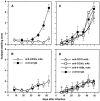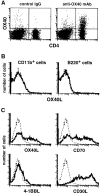Critical contribution of OX40 ligand to T helper cell type 2 differentiation in experimental leishmaniasis
- PMID: 10637281
- PMCID: PMC2195752
- DOI: 10.1084/jem.191.2.375
Critical contribution of OX40 ligand to T helper cell type 2 differentiation in experimental leishmaniasis
Abstract
Infection of inbred mouse strains with Leishmania major is a well characterized model for analysis of T helper (Th)1 and Th2 cell development in vivo. In this study, to address the role of costimulatory molecules CD27, CD30, 4-1BB, and OX40, which belong to the tumor necrosis factor receptor superfamily, in the development of Th1 and Th2 cells in vivo, we administered monoclonal antibody (mAb) against their ligands, CD70, CD30 ligand (L), 4-1BBL, and OX40L, to mice infected with L. major. Whereas anti-CD70, anti-CD30L, and anti-4-1BBL mAb exhibited no effect in either susceptible BALB/c or resistant C57BL/6 mice, the administration of anti-OX40L mAb abrogated progressive disease in BALB/c mice. Flow cytometric analysis indicated that OX40 was expressed on CD4(+) T cells and OX40L was expressed on CD11c(+) dendritic cells in the popliteal lymph nodes of L. major-infected BALB/c mice. In vitro stimulation of these CD4(+) T cells showed that anti-OX40L mAb treatment resulted in substantially reduced production of Th2 cytokines. Moreover, this change in cytokine levels was associated with reduced levels of anti-L. major immunoglobulin (Ig)G1 and serum IgE. These results indicate that anti-OX40L mAb abrogated progressive leishmaniasis in BALB/c mice by suppressing the development of Th2 responses, substantiating a critical role of OX40-OX40L interaction in Th2 development in vivo.
Figures




References
-
- O'Garra A. Cytokines induce the development of functionally heterogeneous T helper cell subsets. Immunity. 1998;8:275–283. - PubMed
-
- Kuchroo V.K., Das M.P., Brown J.A., Ranger A.M., Zamvil S.S., Sobel R.A., Weiner H.L., Nabavi N., Glimcher L.H. B7-1 and B7-2 costimulatory molecules activate differentially the Th1/Th2 developmental pathwaysapplication to autoimmune disease therapy. Cell. 1995;80:707–718. - PubMed
-
- Smith C.A., Farrah T., Goodwin R.G. The TNF receptor superfamily of cellular and viral proteinsactivation, costimulation, and death. Cell. 1994;76:959–962. - PubMed
-
- Gruss H.J., Dower S.K. Tumor necrosis factor ligand superfamilyinvolvement in the pathology of malignant lymphomas. Blood. 1995;85:3378–3404. - PubMed
-
- Sugita K., Torimoto Y., Nojima Y., Daley J.F., Schlossman S.F., Morimoto C. The 1A4 molecule (CD27) is involved in T cell activation. J. Immunol. 1991;147:1477–1483. - PubMed
Publication types
MeSH terms
Substances
LinkOut - more resources
Full Text Sources
Other Literature Sources
Research Materials

